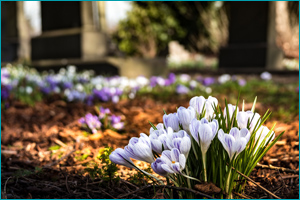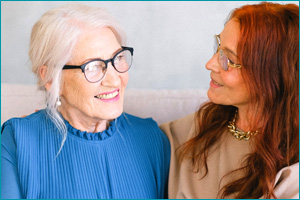Speak up!
If you've written a blog, wish to share a story, or have an idea that you believe would help those visiting the End With Care website, please send it along. If fitting, we'll add your voice to End With Care.
I've got an ideaAn Introduction to the Death Positivity Movement
Posted on April 5, 2022
Our Death Denying Culture
 Although we realize that death will come to us all, it is something that most would just rather not think about. For many, the idea of talking about death is just plain morbid or provokes such anxiety that it is a subject to be avoided. But the past two years of the Covid pandemic and its heart-breaking death toll has become a very real reminder of our humanity. Perhaps it has also become an opportunity to reflect on our mortality. Allowing ourselves to think about and talk about this too often off-limits topic can help alleviate anxieties and fears and can help us acknowledge death as simply the final phase of life. This is the core of the Death Positivity Movement.
Although we realize that death will come to us all, it is something that most would just rather not think about. For many, the idea of talking about death is just plain morbid or provokes such anxiety that it is a subject to be avoided. But the past two years of the Covid pandemic and its heart-breaking death toll has become a very real reminder of our humanity. Perhaps it has also become an opportunity to reflect on our mortality. Allowing ourselves to think about and talk about this too often off-limits topic can help alleviate anxieties and fears and can help us acknowledge death as simply the final phase of life. This is the core of the Death Positivity Movement.
What is the Death Positivity Movement?
The term, the Death Positivity Movement, was coined and popularized by a young funeral director, Caitlin Doughty, in 2011, but many of the movements conceptual roots can be found dating back to the 1970s, including the beginnings of the hospice movement. This was followed by the Natural Death Act, passed in 1976, allowing individuals the right to refuse life sustaining medical intervention. Groundbreaking discussions on death and mortality were to be found in the landmark books, On Death and Dying by Elisabeth Kubler-Ross and The Denial Of Death by Ernest Becker. Add to the mix, the Death Café, developed by Jon Underwood, the first End-of-Life Doula Program in the United States, created by social worker Henry Fersko-Weiss, and the Order of the Good Death, founded in 2011 by the above mentioned, Caitlin Doughty. All of these efforts have contributed to writing the story of the Death Positivity Movement.
In general, the movement acts to remove the stigma around having frank and open discussions on death and seeks to offer education and information on the options, rights, and choices surrounding death. As espoused by The Order of the Good Death, their underlying ideals can be found in their Eight Tenets of the Death Positivity Movement.
The movement embraces the positivity that can be found surrounding death by:
- Realizing the benefits of openly discussing, sharing, and learning about death
- Understanding that planning and becoming involved can help alleviate stress and better prepare for death
- Documenting wants and needs through advance directives, to make sure end-of-life wishes are known and followed
- Being aware of not only traditional, but also natural and environmentally-friendly burial options
Death Positivity sounds like an odd juxtaposition of words. It is important to understand that it is not about feeling positive at the loss of a loved-one or friend or that it is about celebrating death, but rather being able to accept that death is a natural part of life. Our willingness to have open and honest conversations about death can lead to a healthier life and a healthier society.
How We Benefit from Being Death Positive
Openly inviting the notion of death as part of our life can influence how we live in a very impactful and positive way. Accepting our own mortality can help shine a light on how precious our temporary lives can be. Acknowledging that there is no guarantee for tomorrow without the fear of thinking or talking about death can help us more freely live our lives. In his 2005 commencement speech at Stanford University, Steve Jobs noted: “Almost everything, all external expectations, all pride, all fear of embarrassment or failure, these things just fall away in the face of death, leaving only what is truly important."
Accepting our own mortality can help shine a light on how precious our temporary lives can be. Acknowledging that there is no guarantee for tomorrow without the fear of thinking or talking about death can help us more freely live our lives. In his 2005 commencement speech at Stanford University, Steve Jobs noted: “Almost everything, all external expectations, all pride, all fear of embarrassment or failure, these things just fall away in the face of death, leaving only what is truly important."
When we do not face death and try to ignore it, we may be giving up control over many controllable aspects of our death experience. Have you considered your preference of where to die? Have you made your wishes known about life sustaining treatments? Have you prepared your will and other advance care plans? What do you want to happen to your body? What type of funeral would you want?
Discuss your thoughts with your loved ones and document your specific wishes. The idea of making these types of preparations captures a basic idea of being death positive and seeks to inspire individuals to think about and have these important conversations.Some Helpful Resources
For more information and guidance on how to implement your death positivity, the following resources can help.
- The Conversation Project is a resource with downloadable guide that can help you have honest and open conversations with loved ones about your values and wishes at the end of life.
- Honoring Choices Massachusetts is a valuable resource to help inform and empower adults to make health care choices that reflect and honor one’s own care goals, values and choices. Review, download and print the Getting Started Tool Kit and use the easy 1-2-3 step guide to make your health care plan.
- Death Café is a casual facilitated group discussion where people of all ages, backgrounds, genders, and experiences can safely and comfortably gather to talk about death.
- Death Over Dinner provides an on-line tool to help you organize an evening with family and friends to discuss matters related to death at home around the dinner table.
Books
- Being Mortal by Atul Gawande
- From Here to Eternity by Caitlin Doughty
- Stiff by Mary Roach
- Cry, Heart, But Never Break by Glenn Ringtved and Charlotte Pardi, Translated by Robert Moulthrop
- With the End in Mind: Dying, Death, and Wisdom in an Age of Denial by Kathryn Mannix
- The Beauty of What Remains: How Our Greatest Fear Becomes Our Greatest Gift by Steve Leder
- No Death No Fear by Thich Nhat Hanh
While many think death is not an easy subject to talk about, the Death Positivity Movement’s aim is to change this mindset and encourage us to accept death as simply a natural part of life. In doing so, we free ourselves from the fear and anxiety often felt surrounding our mortality. Becoming death positive can empower us to thoughtfully plan for our end-of-life journey and as important, plan for how to more fully live our lives.


